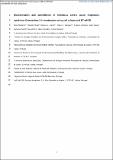Discrimination and surveillance of infectious severe acute respiratory syndrome Coronavirus 2 in wastewater using cell culture and RT-qPCR
Abstract
Severe acute respiratory syndrome coronavirus 2 (SARS-CoV-2) RNA has been extensively detected in raw wastewater in studies exploring wastewater-based epidemiology (WBE) for early warning purposes. Nonetheless, only a few limited studies investigated the presence of SARS-CoV-2 in treated wastewaters to determine the potential health risks across the water cycle. The detection of SARS-CoV-2 has been done mostly by RT-qPCR and ddPCR, which only provides information on the presence of nucleic acids rather than information on potential infectivity. In this study, we set to develop and evaluate the use of viability RT-qPCR for the selective discrimination and surveillance of infectious SARS-CoV-2 in secondary-treated wastewater. Enzymatic (nuclease) and viability dye (Reagent D) pretreatments were applied to infer infectivity through RT-qPCR using porcine epidemic diarrhea virus (PEDV) as a CoV surrogate. Infectivity tests were first performed on PEDV purified RNA, then on infectious and heat-inactivated PEDV, and finally on heat inactivated PEDV spiked in concentrated secondary-treated wastewater. The two viability RT-qPCR methods were then applied to 27 secondary-treated wastewater samples positive for SARS-CoV-2 RNA at the outlet of five large urban wastewater treatment plants in Portugal. Reagent D pretreatment showed similar behavior to cell culture for heat-inactivated PEDV and both viability RT-qPCR methods performed comparably to VERO E6 cell culture for SARS-CoV-2 present in secondary-treated wastewater, eliminating completely the RT-qPCR signal. Our study demonstrated the lack of infectious SARS-CoV-2 viral particles on secondary-treated wastewater through the application of two pretreatment methods for the rapid inference of infectivity through RT-qPCR, showing their potential application in environmental screening. This study addressed a knowledge gap on the public health risks of SARS-CoV-2 across the water cycle.
Citation
Monteiro , S , Rente , D , Cunha , M V , Marques , T A , Cardoso , E , Vilaça , J , Coelho , N , Brôco , N , Carvalho , M & Santos , R 2022 , ' Discrimination and surveillance of infectious severe acute respiratory syndrome Coronavirus 2 in wastewater using cell culture and RT-qPCR ' , Science of the Total Environment , vol. 815 , 152914 . https://doi.org/10.1016/j.scitotenv.2022.152914
Publication
Science of the Total Environment
Status
Peer reviewed
ISSN
0048-9697Type
Journal article
Description
This work was funded by COMPETE (Programa Operacional Competitividade e Internacionalização & Programa Operacional Regional de Lisboa), Portugal 2020 and FEDER funds, in the scope of project “COVIDETECT: Deteção, quantificação e modelação de SARS-CoV-2 em águas residuais como ferramenta de alerta precoce para a disseminação do vírus na comunidade (Ref. 048467, Aviso N.º 15/SI/2020Collections
Items in the St Andrews Research Repository are protected by copyright, with all rights reserved, unless otherwise indicated.

